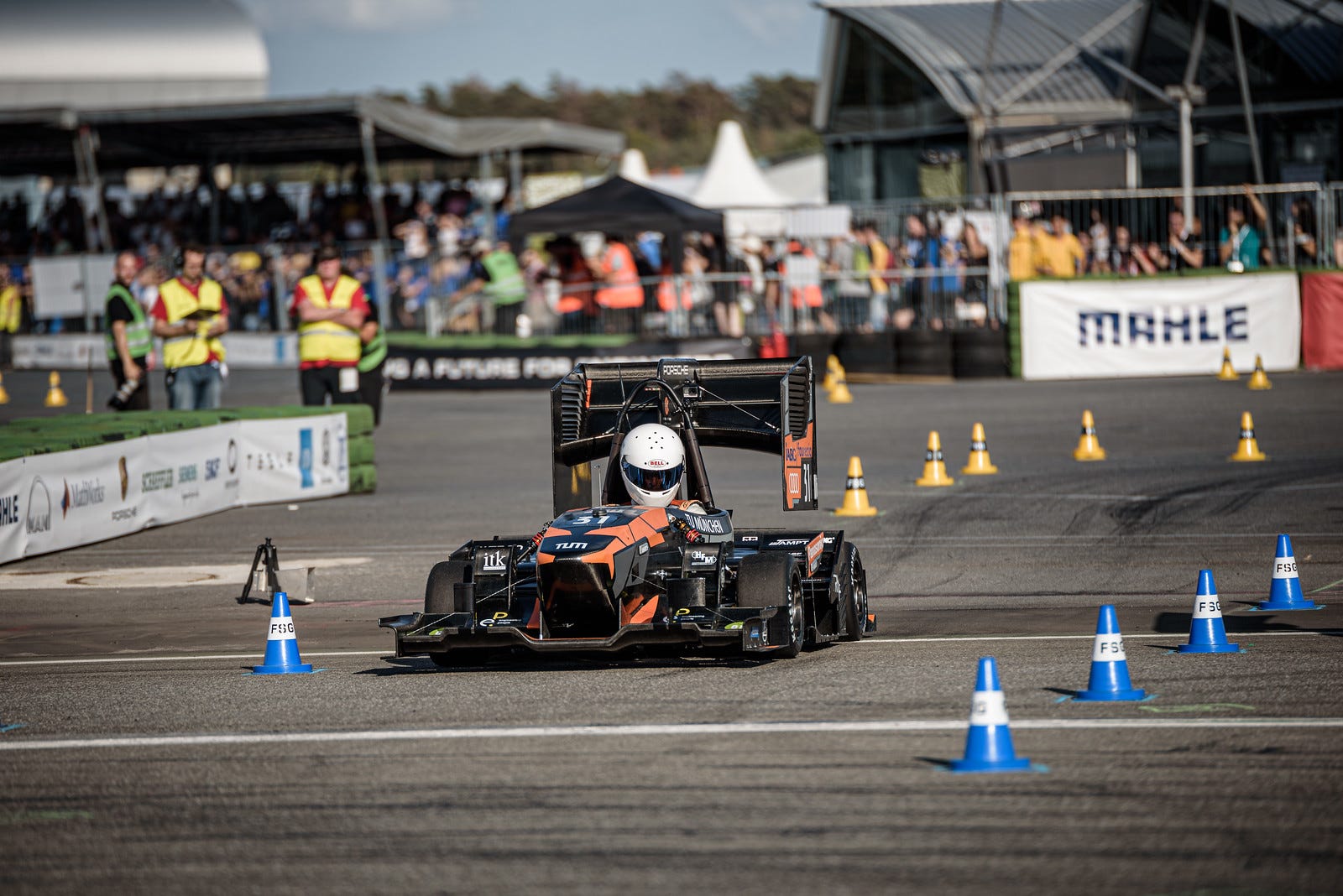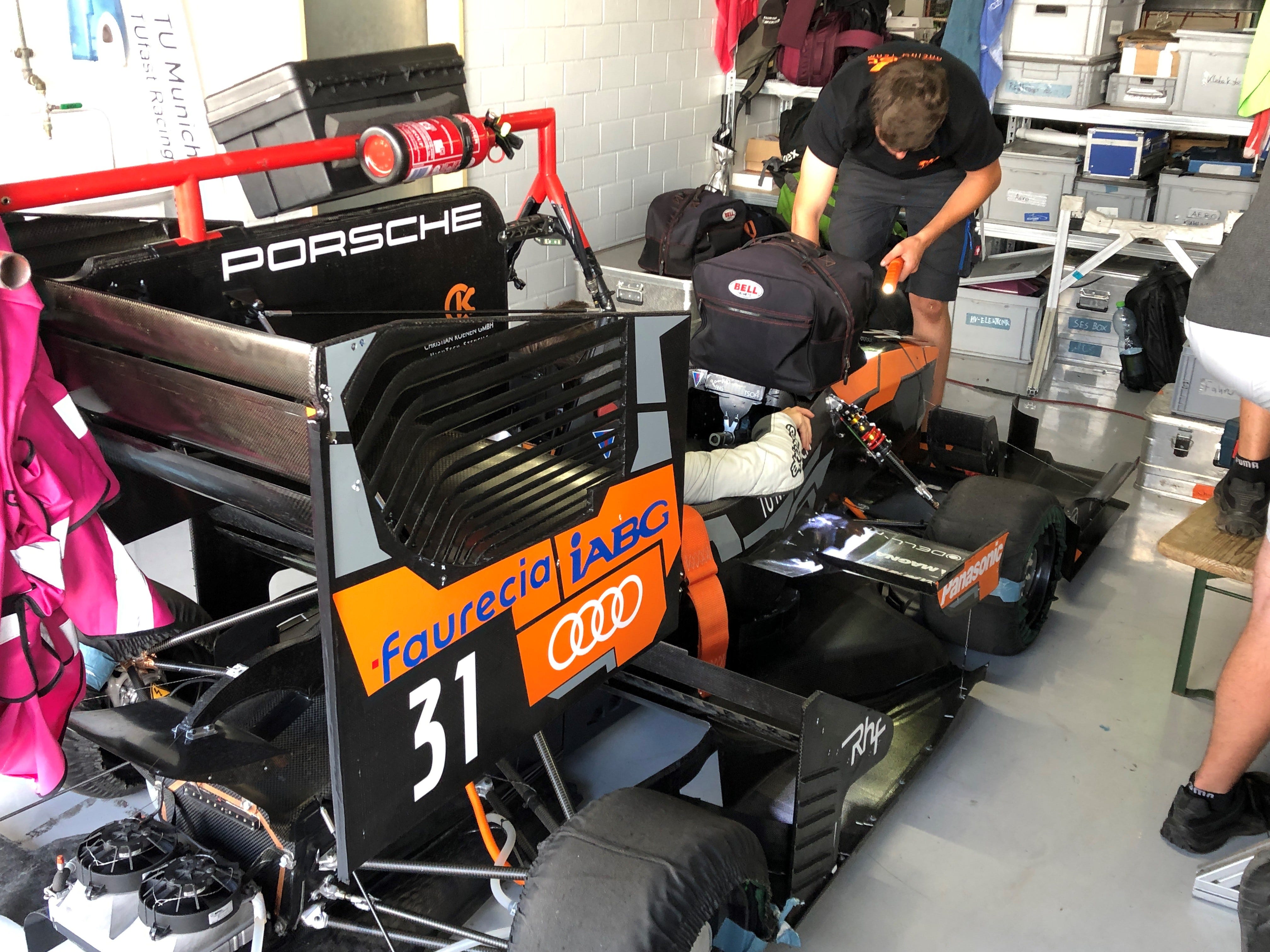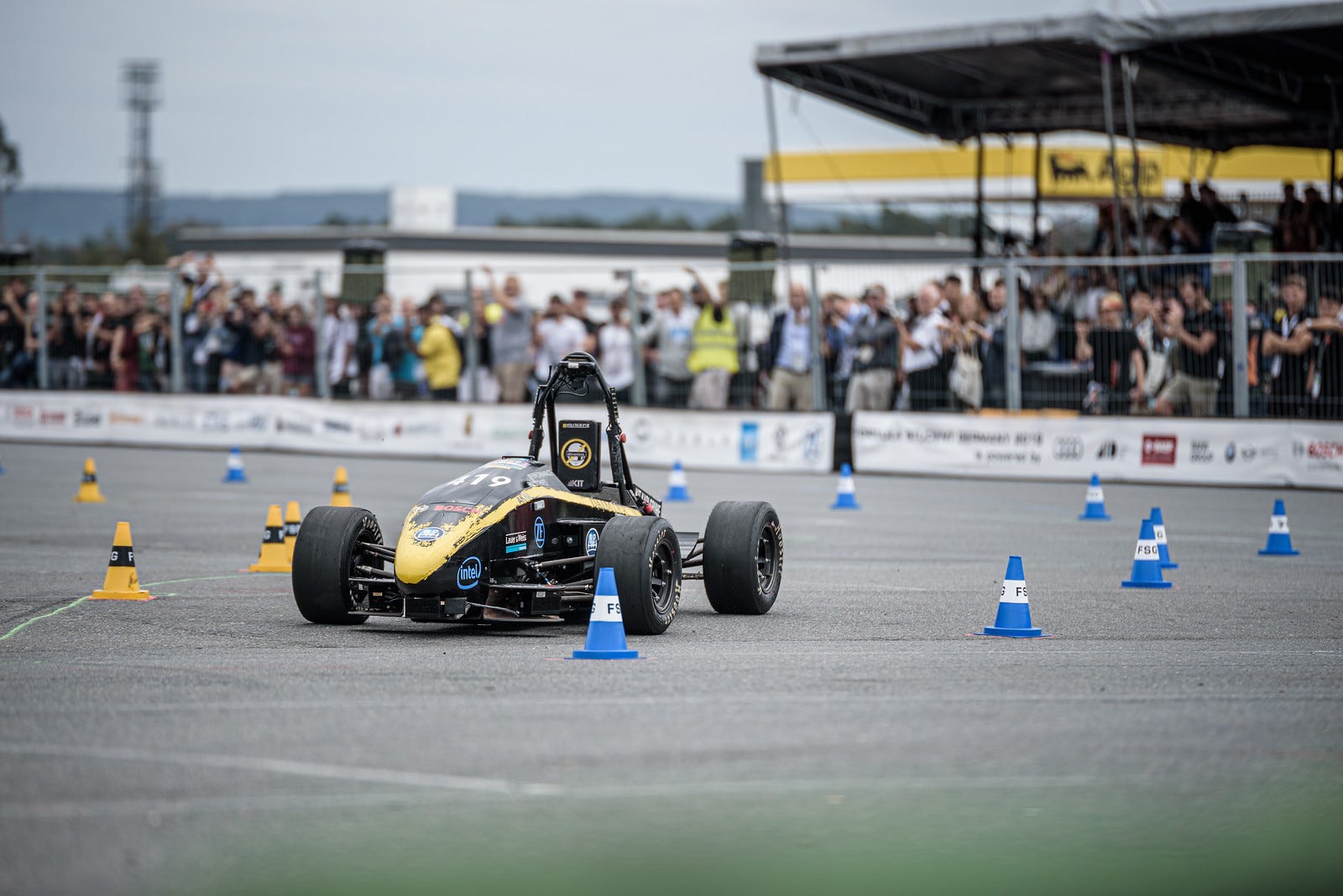Since I joined Porsche in 1990 in the former main department “Research and Sport”, I have never lost my enthusiasm for meaningful motorsport, which supports customer loyalty and technology transfer into our products. 30 years later I’m standing on the Hockenheimring, watching 3,500 students in 119 teams from all over the world present their results from a year of hard work on the racetrack: a single-seater formula racing car.

FSG: Formula Student Germany — or: fascinating, smart and holistic
On August 11, 2019, the finale of this year’s Formula Student Germany (FSG) competition took place at the Hockenheimring. In the three competition classes “FS Combustion (FSC)”, “FS Electric (FSE)” and “FS Driverless (FSD)”, students entered 60 vehicles with combustion engines, 40 electric racing vehicles and 20 self-propelled vehicles. In each class, the overall package consisting of design (engineering design), business model (business plan presentation) and safety check is decisive. Additionally, the driving characteristics of the racing cars — developed and built by the participants themselves — are tested on the race track and included in the overall ranking. A jury of experts from motorsport, the automotive industry and suppliers evaluated the performance of each team.

Static and dynamic disciplines: from business plan to lateral acceleration potential
In the static disciplines, the student teams pitched the various technical aspects of their vehicle to the jurors in discussions and presentations. In engineering design, the jury evaluated the students’ constructive solutions, their understanding of their own design and the demands of a fictitious customer group. Within the cost analysis, participants had to present their calculated production and assembly costs as well as possible alternatives. Part of the FSG competition is to develop a business plan, too, that convinces potential investors to produce the prototype profitably in small series.
The dynamic disciplines test the vehicles with regard to longitudinal and lateral acceleration potential, handling, durability and efficiency. The vehicles will not be admitted to these disciplines until all components of the technical acceptance have been passed. The following disciplines will be driven and evaluated in the yearly FSG competition:
- Skid Pad (figure-eight ride): Measurement of the maximum achievable lateral acceleration during a constant circular movement on an irrigated roadway
- Acceleration test: Acceleration with standing start on a straight line of 75 m length
- Autocross (handling): Passing through a handling course of approx. 800 m in length for a limited period of time
- Endurance (long-distance test): Driving a distance of 22 km on time, evaluation of reliability and energy consumption

2nd place in the category FS Electric, ka.raceing, KIT Karlsruhe, Photo: FSG
Curiosity-driven education: When students do what they really like to do
It is fascinating to see what the students are putting out on the road. The daily work in the FS teams is similar to the training concept of CODE University in Berlin, in which the practical project conveys the teaching content. Curiosity-driven education means to implement innovative things in a project and to learn in a playful way: Seeing the result of their work, the finished racing car, compete, gives the group a special feeling of having achieved something meaningful.
In addition, there is the competitive aspect: the opportunity to test your skills against others and to be rewarded for your work encourages you to master even difficult situations and setbacks, to deal deeply with the subject matter and to improve. I see the FSG on par with competitions such as the Mathematics Olympiad, Lego Mindstorms, Schüler Experimentieren and Jugend Forscht.
To me, FSG is the support of young talent
From my point of view, the Formula Student is a great way to train the next generation of engineers: The conception and construction of an FS vehicle is very close to the work requirements of a vehicle (pre-)developer. That’s why Porsche AG has been supporting various Formula Student Germany teams and vehicles for several years now. In the 2019 season, these were individual vehicles from the ka.racing teams of the University of Karlsruhe (KIT), TUFast (TU Munich) and Ecurie Aix (RWTH Aachen). The teams of the University of Stuttgart (Green Team) and University of Esslingen are supported by the Porsche Engineering Group.

It is always a pleasure for me to support the FS teams sponsored by Porsche at internal judgings and training or to connect them with our development department and suppliers for technical questions. For example, I was able to help the ka.raceing team of the University of Karlsruhe by connecting them with the Porsche Motorsport project 919 Hybrid to design and manufacture the steering system of their racing cars in the 2019 season in a lighter fashion and with less steering play. This makes the vehicles easier and safer to drive in the handling courses.
The results of the e-vehicles
But let’s get back to the essentials — and technical: How did the teams’ electric racing cars perform?

ka.racing is second in the FSE overall ranking behind TUFast with its KIT19e e-vehicle. The KIT19e vehicle stands out in particular due to its four internal, self-developed and manufactured electric machines with 26.7 kW each. On the chassis side, the vehicle has a mechanical lift/roll suspension system that enables the lift and roll spring rates to be adjusted independently of each other. The team relies on 13-inch tires from Continental and uses lightweight, one-piece carbon wheels that are manufactured in-house. The enormous potential of the vehicle and the team is demonstrated by top lap times in the autocross classification and second place in the acceleration test. ka.raceing also achieves second place in the efficiency and acceleration classification in Hockenheim and third place in the design and business plan classifications. The ka.raceing team already won the FSE competition in Hockenheim as overall winner in 2017.

TUFast visits Porsche, Photo: FSG

The TUFast Racing Team of the TU Munich with its e-vehicle №31 is one of the top teams of the 2019 season and has created the undisputed fastest racing vehicle of the category FSE. With a total weight of only 220 kg (incl. driver with 68 kg), the car with its four wheel hub motors is a top performer. TUFast developed ECUs, inverters and a 600V LiPo-HV battery as well as sophisticated aerodynamics on its own. Remarkable are also the slotted rear spoiler winglets, which are supposed to provide a pressure compensation when cornering. TUFast won the FSE category (overall) ahead of ka.raceing as well as the “Skid-Pad”, “Autocross” and “Endurance” classifications in Hockenheim 2019.

Start of the Endurance ranking, Green Team of the University of Stuttgart, Photo: FSG
The Green Team at Stuttgart University (No. E26) is the winning team in the Acceleration and Cost & Manufacturing categories for electric vehicles. In the year of the 10th anniversary and the tenth participation in Hockenheim, self-developed electric machines were used for the first time as wheel hub motors with 4 x 34.5 kW power. They are controlled by an inverter from AMK. With its own motor development, the team is well equipped for the next season as well, since the standard motor supplier of most teams will no longer be available. The 600V LiPo battery with 7.55 kWh is oil-cooled. The new vehicle of the type E7011–10 has victory potential. Unfortunately the FSG 2019 is cancelled in the Endurance competition. The Green Team of the University of Stuttgart already won the FSE competition in Hockenheim in 2010 and 2017 as overall winner.
Results of the Driverless vehicles
The team ka.raceing with their driverless vehicle KIT19d with the no. 419 won the second place (overall) in the category Driverless, and additionally the special price “Daimler Driverless AI Award” as well as the price “Best Emergency Braking System”. In the dynamic tests “Skid-Pad”, “Autocross” and “Trackdrive” the team achieved the 1st place among the Driverless competitors. Second places are also awarded in the “Design” and “Efficiency” categories.

The KIT19d vehicle is equipped with four lidar sensors and two cameras to the front and one camera to the rear. The model-based path planning and guidance is tested in a self-developed simulation environment. This sophisticated trajectory planning always helps to achieve fast times when support by map data is not yet available or is inaccurate. The monocoque and chassis come from a proven 2017 electric racing vehicle with a total weight of 218 kg. The electric drive has 4 internal electric machines, each with an output of 23 kW.
The car with start number 499 was the third self-propelled car of the Ecurie Aix team of RWTH Aachen University. Based on the monocoque and chassis of last year’s electric vehicle, the vehicle was extended by the self-propelled system with two lidar sensors and stereo camera. A sensor fusion connects the object signals from the two redundant sensor systems. Optimum support is provided via GPS. The total weight of the racing car is 231 kg. In the end, this is enough for seventh place in the Driverless category.

Starting number 294 was the winning vehicle of the University Esslingen in the category FSC/Combustion. It is powered by a modified 2-cylinder KTM engine with 706 ccm displacement and Walbro injection. The fuel used is petrol E85. The transmission is a 4-speed sequential transmission. Remarkable on this vehicle are also a rear axle steering system as well as self-designed roll dampers and lift dampers from KW.

Where the journey leads: Automated driving function
Over the next few years, the organisers intend to expand the Formula Student competition primarily in the direction of automated driving functions, including testing longitudinal and lateral control in the acceleration and skid pad disciplines. After the introduction of the e-vehicles in the competition in 2010, this should take the trend towards more automation in road-bound traffic into account. In my view, this is the right development: In this way, we are preparing the student teams even better for the tasks of developing the mobility of the future and researching the most modern technologies.
The event in Hockenheim was a complete success for everyone, participants, spectators, organizers and partners. This year I also took along new, valuable contacts to the students and future talents and was able to deepen existing cooperation over many years. Now I’m off to the next event in Barcelona and the planning for the next season, for which I wish all the teams the best of luck and wish them optimal preparation for the 2020 competition. See you next year in Hockenheim!
Kommentare
Kommentar veröffentlichen